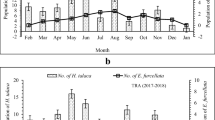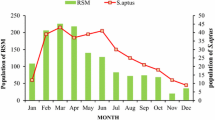Abstract
The tea (Camellia sinensis (L.) Kuntze) industry is the backbone of the agroeconomy of the North Bengal region located at the foothills of the Himalayas in North-East (NE) India. This region accounts for about 25% of the total tea production in India. The tea mosquito bug, Helopeltis theivora Waterhouse, is one of the most devastating sucking pests of tea in this region. Various kinds of synthetic insecticides are continuously sprayed to control this bug. The lynx spider Oxyopes javanus. Thorell has been found to remain associated with tea plants and feed on H. theivora. The present study investigated the predation potential and efficacy of the O. javanus spider against one of its most common prey species, H. theivora. In the laboratory, with an increase in H. theivora density, the predation rate of both male and female O. javanus increased. Per capita predation rates exhibited by male and female O. javanus per day against adult H. theivora were 3.67 ± 1.52 and 11.67 ± 1.53 (mean ± standard deviation), respectively. At a reasonably small prey density, the prey consumption rate was highest, reaching up to 100%, indicating that the spider predator has the potential to eliminate smaller populations of the pest. The predation effectiveness calculated using Holling’s disc equation was 6.08 and 356.58 for male and female O. javanus, respectively. The prey handling time was 0.138 day for male O. javanus and 0.012 day for female O. javanus. Female O. javanus exhibited about fivefold higher searching efficacy than male O. javanus. It appears that the conservation or augmentation of O. javanus in the tea ecosystem can provide effective biological management of the major tea pest, H. theivora, in sub-Himalayan foothills and plains of NE India.
Similar content being viewed by others
References
Bhutia D., Rai B. K. and Pal J. (2013) Detection of multiple cytochrome P450 in hepatic tissue of Heteropneustes fossilis (Bloch) exposed to cypermethrin. Proceedings of the Zoological Society 66, 14–19.
Bishnu A., Chakrabarti K., Chakraborty A. and Saha T. (2009) Pesticide residue level in tea ecosystems of hill and Dooars regions of West Bengal, India. Environmental Monitoring and Assessment 149, 457–464.
Bora S., Sarmah M., Rahaman A. and Gurusubramanian G. (2007) Relative toxicity of pyrethroid and non-pyrethroid insecticides against male and female tea mosquito bug, Helopeltis theivora Waterhouse (Darjeeling strain). Journal of Entomological Research 31, 37–41.
Carter P. E. and Rypstra A. L. (1995) Top-down effects in soybean agroecosystems: spider density affects herbivore damage. Oikos 72, 433–439.
Daniel W. W. (ed.) (1987) Biostatistics: A Foundation for Analysis in the Health Sciences (Probability & Mathematical Statistics). 4th edn. John Wiley & Sons, New York; Chichester. 752 pp.
Das S., Roy S. and Mukhopadhyay A. (2010) Diversity of arthropod natural enemies in the tea plantations of North Bengal with emphasis on their association with tea pests. Current Science (Bangalore) 99, 1457–1463.
Das S., Sarker M. and Mukhopadhyay A. (2005) Changing diversity of hymenopteran parasitoids from organically and conventionally managed tea-ecosystem of North Bengal, India. Journal of Environmental Biology 26, 505–509.
Fagan W. F. and Hurd L. E. (1991) Direct and indirect effects of generalist predators on a terrestrial arthropod community. American Midland Naturalist 126, 380–384.
Givens R. P. (1978) Dimorphic foraging strategies of a salticid spider (Phidippus audax). Ecology 59, 309–321.
Greenstone M. H. (1999) Spider predation: how and why we study it. Journal of Arachnology 27, 333–342.
Gurr G. M., Barlow N. D., Memmot J., Wratten S. D. and Greathead D. J. (2000) A history of methodological, theoretical and empirical approaches to biological control, pp. 3–38. In Biological Control: Measures of Success (edited by G. Gurr and S. Wratten). Kluwer Academic Publishers, Dordrecht.
Gurusubramanian G., Rahman A., Sarmah M., Ray S. and Bora S. (2008) Pesticide usage pattern in tea ecosystem, their retrospects and alternative measures. Journal of Environmental Biology 29, 813–826.
Hoefler C. D., Chen A. and Jakob E. M. (2006) The potential of a jumping spider, Phidippus clarus, as a biocontrol agent. Journal of Economic Entomology 99, 432–436.
Holland J. M., Winder L. and Perry J. N. (2000) The impact of dimethoate on the spatial distribution of beneficial arthropods in winter wheat. Annals of Applied Biology 136, 93–105.
Holling C. S. (1959) The components of predation as revealed by a study of small-mammal predation of the European pine sawfly. The Canadian Entomologist 91, 293–320.
Holling C. S. (1965) The functional response of predators to prey density and its role in mimicry and population regulation. Memoirs of the Entomological Society of Canada 97 (Suppl. S45), 5–60.
Komagata O., Kasai S. and Tomita T. (2010) Overexpression of cytochrome P450 genes in pyrethroid-resistant Culex quinquefasciatus. Insect Biochemistry and Molecular Biology 40, 146–152.
Marc P., Canard A. and Ysnel F. (1999) Spiders (Araneae) useful for pest limitation and bioindication. Agriculture, Ecosystems & Environment 74, 229–273.
Marshall S. D. and Rypstra A. L. (1999) Spider competition in a structurally simple ecosystem. Journal of Arachnology 27, 343–350.
Morin P. J. (2011) Community Ecology, 2nd edn. Wiley-Blackwell, Malden, Massachusetts. 424 pp.
Mukhopadhyay A. and Roy S. (2009) Changing dimensions of IPM in the tea plantations of the North Eastern sub Himalayan region, pp. 290–302. In Proceedings of the National Symposium on IPM Strategies to Combat Emerging Pests in the Current Scenario of Climate Change (edited by V. V. Ramamurthy, G. P. Gupta and S. N. Puri). Entomology Society of India, New Delhi and Central Agricultural University, Pasighat, Arunachal Pradesh.
Muraleedharan N. (2007) Tea insects: ecology and control, pp. 672–764. In Encyclopaedia of Pest Management, 2nd edn. (edited by D. Pimentel). CRC Press, London.
Nyffeler M. and Sunderland K. D. (2003) Composition, abundance and pest control potential of spider communities in agroecosystems: a comparison of European and US studies. Agriculture, Ecosystems & Environment 95, 579–612.
Nyffeler M., Sterling W. L. and Dean D. A. (1994) How spiders make a living. Environmental Entomology 23, 1357–1367.
Oraze M. J. and Grigarick A. A. (1989) Biological control of aster leafhopper (Homoptera: Cicadellidae) and midges (Diptera: Chironomidae) by Pardosa ramulosa (Araneae: Lycosidae) in California rice fields. Journal of Economic Entomology 82, 745–749.
Pedigo L. P. (2002) Entomology and Pest Management, 4th edn. Prentice Hall, New Jersey. 608 pp.
Rattan P. S. (1992) Pest and disease control in Africa, pp. 331–352. In Tea: Cultivation to Consumption (edited by K. C. Wilson and M. N. Clifford). Chapman & Hall, London.
Ray Chaudhuri D. (2011) Assessment of spiders as second order of biocontrol agents in tea ecosystem with special reference to Assam and Dooars of West Bengal, p. 14. In Annual progress report 2010–11. National Tea Research Foundation, Tea Board, B. T. M. Sarani, Kolkata.
Riechert S. E. and Lawrence K. (1997) Test for predation effects of single versus multiple species of generalist predators: spiders and their insect prey. Entomologia Experimentalis et Applicata 84, 147–155.
Riechert S. E. and Lockley T. (1984) Spiders as biological control agents. Annual Review of Entomology 29, 299–320.
Roy S., Mukhopadhyay A. and Gurusubramanian G. (2010) Development of resistance to endosulphan in populations of the tea mosquito bug Helopeltis theivora (Heteroptera: Miridae) from organic and conventional tea plantations in India. International Journal of Tropical Insect Science 30, 61–66.
Rypstra A. L. (1995) Spider predators reduce herbivory; both by direct consumption and by altering the foraging behaviour of insect pests. Bulletin of the Ecological Society of America 76 (Suppl. 3), 383.
Scharf M. E., Neal J. J. and Bennett G. W. (1998) Changes of insecticide resistance levels and detoxification enzymes following insecticide selection in the German cockroach, Blattella germanica (L.). Pesticide Biochemistry and Physiology 59, 67–79.
Spiller D. A. (1986) Interspecific competition between spiders and its relevance to biological control by generalist predators. Environmental Entomology 15, 177–181.
Stiling P. and Cornelissen T. (2005) What makes a successful biocontrol agent? A meta-analysis of biological control agent performance. Biological Control 34, 236–246.
Sunderland K. (1999) Mechanisms underlying the effects of spiders on pest populations. Journal of Arachnology 27, 308–316.
Symondson W. O., Sunderland K. D. and Greenstone M. H. (2002) Can generalist predators be effective biocontrol agents? Annual Review of Entomology 47, 561–594.
Tanaka K., Endo S. and Kazano H. (2000) Toxicity of insecticides to predators of rice planthoppers: spiders, the mirid bug, and the drynid wasp. Applied Entomology and Zoology 35, 177–187.
Van Hook R. I. Jr. (1971) Energy and nutrient dynamics of spider and orthopteran populations in a grassland ecosystem. Ecological Monographs 41, 1–26.
Walker S. E. and Rypstra A. L. (2002) Sexual dimorphism in tropic morphology and feeding behavior of wolf spiders (Araneae: Lycosidae) as a result of differences in reproductive roles. Canadian Journal of Zoology 80, 679–688.
Wise D. H. and Chen B. (1999) Impact of intraguild predators on survival of a forest-floor wolf spider. Oecologia 121, 129–137.
Yardim E. N. and Edwards C. A. (1998) The influence of chemical management of pests, diseases and weeds on pest and predatory arthropods associated with tomatoes. Agriculture, Ecosystems & Environment 70, 31–48.
Author information
Authors and Affiliations
Corresponding author
Rights and permissions
About this article
Cite this article
Basnet, K., Mukhopadhyay, A. Biocontrol potential of the lynx spider Oxyopes javanus (Araneae: Oxyopidae) against the tea mosquito bug, Helopeltis theivora (Heteroptera: Miridae). Int J Trop Insect Sci 34, 232–238 (2014). https://doi.org/10.1017/S1742758414000538
Accepted:
Published:
Issue Date:
DOI: https://doi.org/10.1017/S1742758414000538




